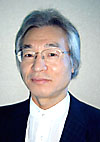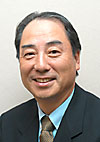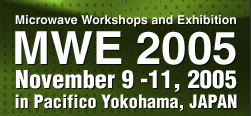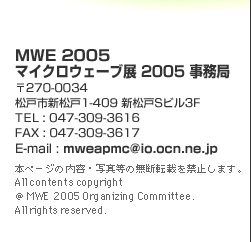MWE 2005 Opening Ceremony and Keynote Address
開会式・基調講演 Keynote Address |
|
| |
| →Back to List |
| |
| 開 会 式 |
11月09日 (水) 10:00−10:10 |
F201 + F202 会議室 |
実行委員長 挨 拶
Opening Ceremony
|
| MWE 2005 実行委員会 委員長 高木 直 (東北大) |
|
|
|
| 基 調 講 演 |
11月09日 (水) 10:10−12:10 |
F201 + F202 会議室 |
1. 超高速を狙うブロードバンド移動無線技術
Broadband Mobile Wireless Techniques
|
| 安達 文幸 (東北大) [司 会] 高木 直 (東北大) |
|
|
 第4世代移動通信システムでは、100Mbpsから1Gbpsにいたる無線アクセス技術が求められている。これまでマルチキャリアCDMA(MC-CDMA)が脚光を浴びてきたが、最近、周波数領域等化を用いる直接拡散CDMA(DS-CDMA)も浮上してきた。次世代システムはパケット伝送が主流になるから、誤り訂正と組み合わせたハイブリッド自動再送が重要な誤り制御技術になる。また、移動端末の送信電力低減は重要な技術課題であり、最近注目され出したのはマルチホップ無線技術である。 第4世代移動通信システムでは、100Mbpsから1Gbpsにいたる無線アクセス技術が求められている。これまでマルチキャリアCDMA(MC-CDMA)が脚光を浴びてきたが、最近、周波数領域等化を用いる直接拡散CDMA(DS-CDMA)も浮上してきた。次世代システムはパケット伝送が主流になるから、誤り訂正と組み合わせたハイブリッド自動再送が重要な誤り制御技術になる。また、移動端末の送信電力低減は重要な技術課題であり、最近注目され出したのはマルチホップ無線技術である。
本講演では、これら最新のブロードバンド移動無線技術について紹介する。
A very high-speed wireless access of 100Mbps to 1Gbps is required for the 4th generation(4G) mobile communications systems. A promising wireless access technique that can overcome the channel frequency-selectivity and even take advantage of this selectivity to improve the transmission performance is code division multiple access(CDMA). There are two approaches in CDMA technique: direct-sequence(DS) - CDMA and multi-carrier(MC) -CDMA. A lot of attention has been paid to MC-CDMA. However, recently it has been revealed that DS-CDMA can achieve a good performance comparable to MC-CDMA if proper frequency-domain equalization is adopted. A major transmission mode in 4G systems will be packet based.
Automatic repeat request(ARQ) combined with channel coding is a very important technique. Furthermore, reducing the mobile terminal transmission powers is an important technical issue.
Fundamental change is necessary in wireless access network architecture. An efficient solution may be an introduction of multi-hop technique. We will discuss about the state of the art of these broadband mobile wireless techniques for 4G systems. |
|
| |
2. デジタル放送と今後の展開
Digital Broadcasting and Beyond
|
| 榎並 和雅 (NHK) |
{司 会] 高木 直 (東北大) |
|
|
 2000年に衛星デジタル放送(12GHz帯)が開始された。また2003年には、東名阪で地上デジタル放送(UHF帯)が開始され、その後も続々と地域の放送局で開始されている。2005年末には、日本のほぼ60%に相当する世帯が、地上デジタル放送を受信できるようになる。デジタル受信機の販売も好調である。来年以降、携帯端末向けサービスやサーバー型放送が開始される予定であり、デジタル放送によって「いつでも、どこでも、誰とでも」というユビキタス社会が実現しつつある。一方では、ブロードバンドによる放送番組の配信も盛んに行われるようになってきた。 2000年に衛星デジタル放送(12GHz帯)が開始された。また2003年には、東名阪で地上デジタル放送(UHF帯)が開始され、その後も続々と地域の放送局で開始されている。2005年末には、日本のほぼ60%に相当する世帯が、地上デジタル放送を受信できるようになる。デジタル受信機の販売も好調である。来年以降、携帯端末向けサービスやサーバー型放送が開始される予定であり、デジタル放送によって「いつでも、どこでも、誰とでも」というユビキタス社会が実現しつつある。一方では、ブロードバンドによる放送番組の配信も盛んに行われるようになってきた。
講演では、こうした放送を取り巻くデジタル化の現状とその後の展開について述べる。。
In 2000, Digital Satellite Broadcasting began in Japan and Digital Terrestrial broadcasting started in Tokyo, Nagoya and Osaka in 2003, followed by the other areas progressively, resulting in being covered with about 60% of the number of households at the end of the year 2005. New broadcasting services which are viewed on a portable receiver and based on a Home Server are to start after the next fiscal year. Digital broadcasting has been establishing "Ubiquitous Society" which means realization of "at anytime", "anywhere" and "with anyone".
On the other hand, broadcasting services using broadband network has been popularized. The present situation surrounding the digital broadcasting and its future will be discussed in this presenta |
|



